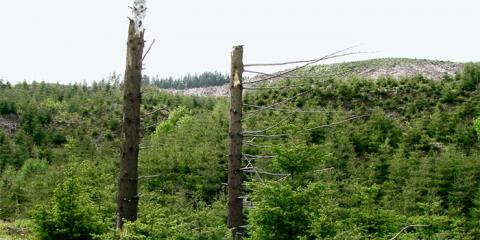The value of dead wood
July 23, 2013
I recently attended a conference on “Wildlife in Managed Forests” sponsored by OFRI, the Oregon Society of American Foresters and the Oregon chapter of The Wildlife Society. Speakers discussed current research on wildlife damage and wildlife habitat enhancement projects across western Oregon and Washington. There was far too much interesting stuff to relate in this space, so in this post I’ll focus on one recurring theme of the meeting: dead wood.
One of the easiest and most effective ways to maintain a wildlife-friendly forest is to retain dead wood as snags (standing dead trees) and down wood (logs on the ground).
Nearly 100 species of animals in Oregon – mostly birds – use snags. First, birds such as woodpeckers forage on insects living in these trees and then excavate cavities in the trees for nesting. Later, these cavities are used by other birds and mammals for nesting and shelter. Raptors such as hawks may also use snags as perches, from which they can prey on voles or other mammals.
With snags, the rule of thumb is “bigger is better” – smaller-diameter snags will only be used by smaller animals and do not last as long. So if scattered trees die on your property, consider leaving them for wildlife, keeping safety in mind. Snags can also be created artificially during harvest. Mechanical harvesters can top trees up to 20 feet or so, and so can create a snag out of a tree with a defect down low but a merchantable top. The second-best option, if you cannot safely cut the tree up high, is to fell the tree and leave the defective portion in the woods where wildlife will use it. Now it has become “down wood.”
Just a few days after the workshop, I visited a landowner near Rainier. A small harvest had just been completed, and the logger had left a big, defective log alongside the unit. The owner wondered, could it have been sold as a pulp log? Should she see if someone wanted it for firewood? I suggested that the log was already providing value, and probably more than what might have ended up in her wallet from these potential uses. Down wood is used for cover, travel corridors and breeding spaces, and is especially important for amphibians such as newts.
The naturally regenerated alder in the background had come in after a harvest that had left little to no wood on the ground. The foreground will soon be planted back to conifers, which will take decades to reach a size that will provide a new source of snags or down wood. By carrying over some down wood like the log in the photo from one forest generation to the next, a landowner can ensure some continuity of these wildlife-friendly habitat elements. Consider not disturbing down logs that are already in your forest. They’re playing an important role – and besides, your equipment may take a beating if you try to move them or run them over!
Have you created or left snags or down wood on your property? Do you have evidence of wildlife using these structures? I would like to create a photo gallery. Send me a photo of dead wood in your forest with a description of how it came to be or what wildlife you think is using it. If I get enough responses, I’ll share them all in a future article.
For more information on managing for wildlife, check out “Wildlife in Managed Forests: Oregon Forests as Habitat,” published by OFRI. You can find it and many other publications about forest wildlife at KnowYourForest.org.
Amy Grotta
OSU Extension Forester
Columbia, Washington and Yamhill Counties
http://blogs.oregonstate.edu/treetopics/
